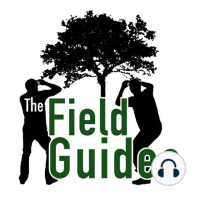35 min listen
Ep. 64 - Let's Look at the Eclipse! (Not Literally)
FromThe Field Guides
ratings:
Length:
60 minutes
Released:
Apr 1, 2024
Format:
Podcast episode
Description
Who doesn’t love an eclipse? Apparently, wildlife has very mixed feelings about the whole affair. This month, the guys prepare for the upcoming 2024 total eclipse by looking into the research around how animals react to the moon photobombing the sun for a few minutes. The reactions are not universal, but they are varied. And trying to figure out what the animals are up to makes for a fascinating listen. This episode was recorded on March 20, 2024 at Reinstein Woods Nature Preserve in Cheektowaga, NY.Episode NotesBill mentioned that “wind is air moving between temperature differences.” When listening back to the episode during editing, he worried that maybe he was wrong on that. Looking it up, he did find some websites claiming that wind is due to differences in air pressure and that temperature has little to do with it, but it turns out that’s not quite true either. According to the good people at NOAA (The National Oceanic and Atmospheric Administration, the organization referred to in this episode), the answer is both. Their short answer to “what makes wind?” is that it’s the movement of gases from high-pressure areas to low-pressure areas. BUT, they go on to say that the main cause of wind is actually temperature. More specifically, it’s differences in temperature that lead to different air pressures.It all starts because as the sun warms up the air on the Earth, it does so unevenly. Because the sun hits different parts of the Earth at different angles, and because Earth has oceans, mountains, and other features, some places are warmer than others. Because of this, we get pockets of warm air and cold air.Since gases behave differently at different temperatures, that means you also get pockets with high pressure and pockets with low pressure. Generally speaking (and notice we said generally), in areas of high pressure, the gases in the air are colder and more crowded. In low pressure zones, the gases are warmer and a little more spread out. And this is why wind happens. Gases move from high-pressure areas to low-pressure areas. And the bigger the difference between the pressures, the faster the air will move from the high to the low pressure. That rush of air is the wind we experience.Bill stated that perigee when the moon is farthest from the Earth. WRONG! The point in the moon's orbit where it is farthest from the earth is called apogee, while it's closest approach is known as perigee.Steve mentioned he though an eclipse viewer was like a camera obscura, and he was correct! A camera obscura is a darkened room with a small hole or lens at one side through which an image is projected onto a wall or table opposite the hole. The camera obscura was used to study eclipses without the risk of damaging the eyes by looking directly into the Sun. From WikpediaLinks Ways to get involved recording weather and/or animal behaviors during the eclipse:The Eclipse Soundscapes Project is a NASA Citizen Science project that's studying how eclipses affect life on EarthSolar Eclipse Safari is another Citizen Science option that invites you to collect data on animals and their behaviors during the eclipse. This project looks at domestic and well as wild animals. https://www.greatamericaneclipse.com/ - a great website for general info about eclipses What Do Birds Do During a Total Eclipse? - an article compiling eBird sightings and descriptions of bird behavior during the 2017 eclipse, including an animation of radar data that shows bird activity during totality Sponsors and Ways to Support UsGumleaf Boots, USA (free shipping for patrons)Thank you to Always Wandering Art (Website and Etsy Shop) for providing the artwork for many of our episodes! Support us on Patreon!Check out the Field Guides merch at our Teespring store. It’s really a great deal: you get to pay us to turn your body into a billboard for the podcast!Works CitedBuckley, E.M.B., Caven, A.J., Gottesman, B.L., Harner, M.J., Pijanowski, B.C. and Forsberg, M.L., 2018. Assessing
Released:
Apr 1, 2024
Format:
Podcast episode
Titles in the series (81)
Ep. 16 - (Dont?) Feed The Birds, Nerds! by The Field Guides
